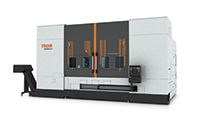by Kip Hanson
Going farther with traveling column machining centres
A fair number of CNC machine tool builders offer at least one model of traveling column vertical machining centre (VMC). DMG MORI, for example, has its DMF linear series of vertical mill. Amera-Seiki, Kent USA, Chevalier, and Racer International offer similar designs, to name a few. And though not considered a machining centre, Okuma utilizes a traveling column design on its Multus U-series multitaskers.
Most of these builders advertise that traveling column machines provide greater efficiency than traditional VMCs. They also boast higher weight capacities, greater stability, decreased load and unload times, and smaller footprints. The question then becomes—if all this is true and traveling column designs are the blue-chip workhorse of the machining world, why aren’t they more popular?
Machine greatness
Andy McNamara, director of sales at Doosan Machine Tools America Ltd., says traveling column VMCs are more popular than many might expect. “We have a range of models, including the VC and VCF-series, and our XC 4000, which is a twin-spindle machine,” he says. “These are generally available in either three or five axis versions, and most can be equipped with various pallet changing and rotary table options.”
McNamara listed off a dizzying array of configurations. Because the table is usually quite long on a traveling column machine, it’s possible to set one up with multiple pallets, with separate work zones for each. This makes it easy to load and unload on one side of the machine while the spindle is busy making parts on the other. And because of this large working envelope, there’s no need to tear down a rotary table to make way for a pair of vises or break into a long running job for a quick prototype—just move to a different section of the table and get to work.
These capabilities help explain the comments about flexibility and load-unload time made earlier. The fixed table design also makes for a smaller footprint, and the ability to machine much larger parts than is possible with traditional VMCs, where the moving table restricts how much weight it can carry. For these reasons and others, McNamara says traveling column machines are common in the automotive market and other high-production machining sectors, where spindle uptime is key.
Okay, but…
Detractors of these machines suggest that the design presents certain limitations, and that moving the significant mass of a vertical column and its spindle (or spindles), for instance, reduces rapid traverse rates. McNamara says that might be true in certain situations and with some builders, but he’s quick to point out that Doosan has addressed this with improved engineering.
“A moving column can work against the builder, but this is why you have to design the machine around it,” he says. “For example, we use a granite-like polymer base, which provides the dampening and stiffness needed to counteract a large moving mass. As a result, we’re able to achieve acceleration rates of up to 1G acceleration on some of our models, with rapids of more than 60 meters-per-minute.”
Take a hard look at the fixed table approach and you’ll see that it offers tremendous benefits, he adds. “Having left and right working zones makes continuous operation quite easy, whether automated or not. You can equip a traveling column machine with different tilt and rotary table combinations or stick a pallet changer on one side and leave the other side for low-volume work, or strip everything off the bed to make room for an oversized workpiece. It’s just a very flexible design.”
 The comfort factor
The comfort factor
Mike Kercher listed another benefit rarely heard in the context of machine tools: comfort. A technical and applications specialist at Mazak Corp., he explains that, because the workpiece on a traveling column mill remains stationary during machining, many people find them easier to program. “It’s a comfort thing,” Kercher says. “A lot of machinists like the fact that you clamp the part to the table and it stays right there, with the cutting tool moving around it. It’s easier to visualize the X and Y axes than with a traditional machining centre.”
Kercher agrees that there’s a strong market for traveling column machines. In Mazak’s case, this is the VTC-series (short for vertical traveling column), available with a CAT40 or CAT50 spindle, multiple table sizes and X-axis travels up to 3000 mm (118.11 in.), and an optional, removable table partition. Five axis machining is possible, as are synchronized but opposing rotary tables for supporting long workpieces from each end simultaneously.
This last option is especially important to the aerospace industry, where bulkheads, beams, and similarly long, slender components are common. For these applications, Mazak also offers 18,000 rpm and 20,000 rpm spindle options, as well as several models with a swiveling, B axis head for complex part geometries.
“These machines are also common for agricultural uses, oil and gas, and so on, where you might be talking about workpieces weighing 5,000 lb (2267 kg) or more,” says Kercher. “And as already mentioned, traveling column machining centres are also quite popular with job shops, this due to their flexibility and, when equipped with a movable partition, higher spindle utilization. For the right mix of parts, they’re tough to beat.” SMT
